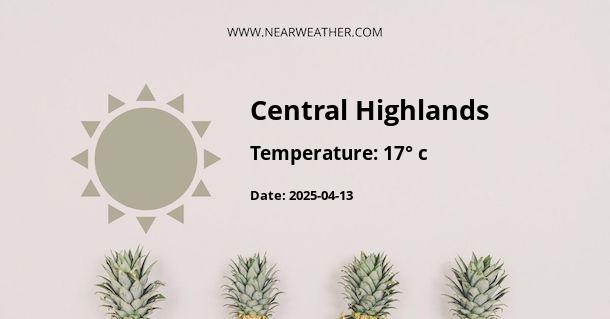Central Highlands, Australia: Climate and Weather Overview
Australia's Central Highlands region is known for its diverse climate, with varying weather patterns throughout the year. Located in the state of Victoria, the Central Highlands is characterized by its mountainous terrain, lush forests, and abundant wildlife. The region experiences distinct seasons, each offering its own unique climate and outdoor activities.
Seasonal Weather Patterns
The Central Highlands experiences four distinct seasons: summer, autumn, winter, and spring. Each season brings its own set of weather conditions, making the region an appealing destination for outdoor enthusiasts year-round.
Summer (December - February)
During the summer months, the Central Highlands experience warm temperatures, with average highs ranging from 25°C to 30°C (77°F to 86°F). This season is characterized by long days and ample sunshine, making it an ideal time for outdoor activities such as hiking, fishing, and wildlife spotting.
Autumn (March - May)
Autumn in the Central Highlands brings cooler temperatures and stunning foliage as the region's forests transform into a kaleidoscope of red, orange, and yellow. Average temperatures range from 12°C to 20°C (54°F to 68°F), providing comfortable conditions for exploring the area's renowned trails and scenic vistas.
Winter (June - August)
Winter in the Central Highlands is characterized by cool to cold temperatures, with average highs ranging from 7°C to 12°C (45°F to 54°F). The region's higher elevations may experience snowfall, creating opportunities for winter sports such as skiing and snowboarding in areas like the popular Mount Buller resort.
Spring (September - November)
As spring arrives, the Central Highlands undergo a stunning transformation, with wildflowers blooming and wildlife becoming more active. Average temperatures range from 10°C to 18°C (50°F to 64°F), making it an excellent time for nature walks, birdwatching, and exploring the region's picturesque landscapes.
Annual Climate Overview
The climate of the Central Highlands is influenced by its elevation and proximity to the coast, resulting in varied weather conditions throughout the year. The following table provides an overview of the region's average climate data:
| Month | Average High (°C) | Average Low (°C) | Precipitation (mm) |
|---|---|---|---|
| January | 27 | 12 | 60 |
| February | 27 | 12 | 55 |
| March | 25 | 10 | 65 |
| April | 21 | 7 | 70 |
| May | 17 | 5 | 80 |
| June | 13 | 3 | 100 |
| July | 12 | 2 | 100 |
| August | 13 | 3 | 90 |
| September | 16 | 5 | 80 |
| October | 19 | 7 | 70 |
| November | 22 | 9 | 65 |
| December | 25 | 11 | 65 |
Source: Australian Government Bureau of Meteorology
Extreme Weather Events
While the Central Highlands typically enjoy mild and pleasant weather, the region can occasionally experience extreme weather events such as heatwaves, bushfires, and severe storms. Visitors are advised to stay informed about weather forecasts and any relevant warnings issued by local authorities, especially during the summer months.
Conclusion
The Central Highlands of Australia offer a diverse and ever-changing climate, inviting visitors to experience the beauty of its landscapes in every season. Whether it's exploring lush forests in autumn, enjoying winter sports in the snow-covered mountains, or witnessing the vibrant renewal of spring, the region's climate and weather make it a captivating destination for nature lovers and outdoor enthusiasts alike.
Plan your visit to the Central Highlands and immerse yourself in the breathtaking natural surroundings that define this remarkable region of Australia.
A - Central Highlands's Latitude is -42.196529 & Longitude is 146.639343.
A - Weather in Central Highlands is 3° today.
A - Climate Conditions in Central Highlands shows light rain today.
A - Humidity in Central Highlands is 96% today.
A - Wind speed in Central Highlands is 5.04 km/h, flowing at 328° wind direction. today.
